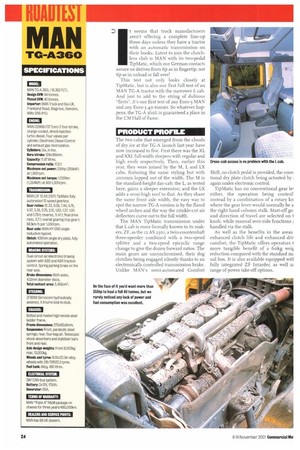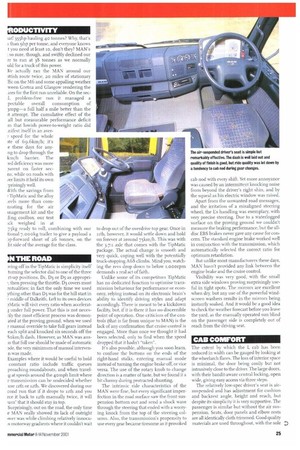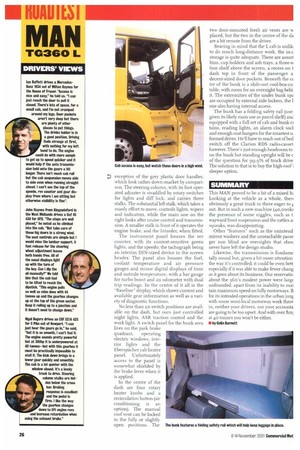t seems that truck manufacturers aren't offering a complete line-up
Page 24

Page 25

Page 26

If you've noticed an error in this article please click here to report it so we can fix it.
these days unless they have a tractor with an automatic transmission on their books. Latest to join the clutchless club is MAN with its two-pedal Tip Matic, which our German contacts
assure us derives from tip as in fingertip, not tip as in unload or fall over!
This test not only looks closely at TipMatic, but is also our first full test of an MAN TG-A tractor with the narrower L cab. And just to add to the string of dubious "firsts", it's our first test of any Euro-3 MAN and any Euro-3 4o-tormer. So whatever happens, the TG-A 36 o L is guaranteed a place in the CM Hall of Fame.
PRODUCT PROFILE
The two cabs that emerged from the clouds of dry ice at the TG-A launch last year have now increased to five. First there was the XL and XXL full-width sleepers with regular and high roofs respectively. Then, earlier this year, they were joined by the M, L and LX cabs, featuring the same styling but with 200MM lopped out of the width. The M is the standard-height day-cab; the L, as tested here, gains a sleeper extension; and the LX adds a semi-high roof to that. As they share the same front axle width, the easy way to spot the narrow TG-A version is by the flared wheel arches and the way the crinkle-cut air deflectors curve out to the full width.
The MAN TipMatic transmission under that L cab is more formally known to its makers, Zr, as the 12 AS 2301, a twin-countershaft three-speeder combined with a two-speed splitter and a two-speed epicyclic range change to give the dozen forward ratios. The main gears are unsynchronised, their dog clutches being engaged silently thanks to an electronically controlled transmission brake, Unlike MAN's semi-automated Comfort
Shift, no clutch pedal is provided, the cony, tional dry plate clutch being actuated by again under electronic control.
Tip Matic has no conventional gear le, either, the operation being control] instead by a combination of a rotary kn where the gear lever would normally be a the right hand column stalk. Start-off ge. and direction of travel are selected on knob, while manual over-ride functions handled via the stalk.
As well as the benefits in the areas enhanced clutch life and enhanced dril comfort, the TipMatic offers operators more tangible benefit of a 6okg weif reduction compared with the standard nu ual box. It is also available equipped wit] fully integrated Z F Intarder, as well aE range of power take-off options.
ODUCT1VITY
iat! 355hp hauling 40 tonnes? Why, that's 3 than 9hp per tonne, and everyone knows t you need at least to, don't they? MAN's : so sure, though, and swiftly declined our
to run at 38 tonnes as we normally uld for a truck of this power.
Ve actually ran the MAN around our yttish route twice, zo miles of stationary Ffic on the MG and some appalling weather ween Gretna and Glasgow rendering the nes for the first run unreliable. On the sec3, problem-free run it managed a pectable overall consumption of 3mpg—a full half a mile better than the a attempt. The cumulative effect of the all but measurable performance deficit rn that lowish power-to-weight ratio did Lni fest itself in an aver! speed for the whole ite of 6 9 .61(m/h; it's e these days for anyng to drop through the km/h barrier. The !ed deficiency was more Darent on faster secns, while on roads with :er limits it held its own prisingly well.
Nith the savings from TipMatic and the alloy :eels more than cornnsating for the air inagement kit and the ling coolbox, our test Lck weighed in at 75kg ready to roll, combining with our tional 7,0 ookg trailer to give a payload a ap-forward short of 26 tonnes, on the ht side of the average for the class.
N THE ROAD
aving off in the TipMatic is simplicity itself turning the selector dial to one of the three it-up positions, Di, D3 or D5 as appropri., then pressing the throttle. D3 covers most nti.talities; in fact the only time we used ything other than D3 was for the hill start in middle of Dalkeith. Left to its own devices aMatic will visit every ratio when accelerat; under full power. That this is not neces:ily the most efficient process was demonated at the proving ground, when we used manual override to take full gears instead each split and knocked six seconds off the Sokin/h dash. However, as MAN was anxIs that full use should be made of automatic ade, the very minimum of manual intervenn was made.
Examples where it would be useful to hold constant ratio include traffic queues proaching roundabouts, and when travel,g at speeds around the 40 mph limit where e transmission can be undecided whether use iith or 12th. We discovered during our cond run that if it drops to iith and you rce it back to 12th manually twice, it will tarn" that it should stay in top.
Surprisingly, out on the road, the only time e MAN really showed its lack of outright rwer was while climbing relatively innocuLs motorway gradients where it couldn't wait
to drop out of the overdrive top gear. Once in tith, however, it would settle down and hold on forever at around 75km/h. This was with the 3.7:1 axle that comes with the TipMatic package. The actual change is smooth and very quick, coping well with the potentially truck-stopping A68 climbs. Mind you, watching the revs drop down to below 1,000rpm demands a real act of faith.
Unlike some of its competitors TipMatic has no dedicated function to optimise transmission behaviour for performance or economy, relying instead on its electronic brain's ability to identify driving styles and adapt accordingly. There is meant to be a kickdown facility, but, if it is there it has no discernible point of operation. One criticism of the controls (that is far from unique to MAN) is the lack of any confirmation that cruise control is engaged. More than once we thought it had been selected, only to find when the speed dropped that it hadn't "taken".
It's also possible, although you soon learn, to confuse the buttons on the ends of the right-hand stalks, entering manual mode instead of turning the engine brake off, or vice versa. The use of the rotary knob to change direction is a matter of taste, but we found it a bit clumsy during protracted shunting.
The intrinsic ride characteristics of the MAN were fine, but every significant imperfection in the road surface saw the front suspension bottom out and send a shock wave through the steering that ended with a worrying knock from the top of the steering column. Also, the transmission's propensity to use every gear became tiresome as it provoked
cab nod with every shift. Yet more annoyance was caused by an intermittent knocking noise from beyond the driver's right shin, and by the squeal as his electric window was raised.
Apart from the unwanted road messages, and the irritation of a misaligned steering wheel, the L's handling was exemplary, with very precise steering. Due to a waterlogged surface on the proving ground we couldn't measure the braking performance, but the alldisc EBS brakes never gave any cause for concern. The standard engine brake worked well in conjunction with the transmission, which automatically selected the correct ratio for optimum retardation.
But unlike most manufacturers these days, MAN hasn't provided any link between the engine brake and the cruise control.
Visibility was very good, with the small extra side windows proving surprisingly useful in tight spots. The mirrors are excellent when dry, but any use of the powerful windscreen washers results in the mirrors being instantly soaked. And it would be a good idea to check the weather forecast before you leave the yard, as the manually operated sun blind on the passenger side is completely out of reach from the driving seat.
CAB COMFORT
The extent by which the L cab has been reduced in width can be gauged by looking at the wheelarch flares. The loss of interior space is minimal, the door being cosily but not intrusively close to the driver. The large doors, with their bandit-aware central locking, open wide, giving easy access via three steps.
The relatively low-spec driver's seat is airsuspended and has adjustment for cushion and backrest angle, height and reach, but despite its simplicity it is very supportive. The passenger is similar but without the air suspension. Seats, door panels and elbow rests are all identically cloth trimmed. Good quality materials are used throughout, with the sole
0 exception of the grey plastic door handles, which look rather down-market by comparison. The steering column, with its foot operated adjuster is straddled by rotary switches for lights and diff lock, and carries three stalks. The substantial left stalk, which takes a manly effort to move, controls lights, wipers and indicators, while the main one on the right looks after cruise control and transmission. A smaller stalk in front of it operates the engine brake, and the I ntarder, when fitted.
The instrument panel houses the rev counter, with its context-sensitive green lights, and the speedo; the tachograph being an interim DIN-sized device in the screen header. The panel also houses the fuel, coolant temperature and air pressure gauges and minor digital displays of time and outside temperature, with a bar gauge for turbo boost and an odometer with dual trip readings. In the centre of it all is the "Baseline" display, which shows current and available gear information as well as a variety of diagnostic functions.
No less than zo switch positions are available on the dash, but ours just controlled night lights, ASR traction control and the work light. A switch panel for the bunk area lives on the park brake quadrant, operating electric windows, interior lights and the Eberspacher cab heater panel. Unfortunately access to the panel is somewhat shielded by the brake lever when it is applied.
In the centre of the dash are four rotary heater knobs and a recirculation button (air conditioning is an option). The manual roof vent can be locked in the fully or slightly
two door-mounted fresh air vents are NM placed, but the two in the centre of the da are a bit remote from the driver.
Bearing in mind that the L cab is unlik to do much long-distance work, the in-c storage is quite adequate. There are assort bins, cup holders and ash trays, a three-s, tion shelf above the screen, a recess on t dash top in front of the passenger a decent-sized door pockets. Beneath the c( tre of the bunk is a slide-out cool-box-cu. table, with room for an overnight bag behi it. The extremities of the under bunk spa are occupied by external side lockers, the I one also having internal access.
The bunk has a folding safety rail (use. given its likely main use as parcel shelf) anc equipped with a full set of cab and bunk ci tains, reading lights, an alarm clock sod and enough coat hangers for the smartest u formed driver. He'll have to reach out of bed switch off the Clarion RDS radio-casset however. There's just enough headroom to on the bunk but standing upright will be c of the question for 99.9% of truck drive The solution to that is to buy the high-roof I sleeper option.
SUMMARY
This MAN proved to be a bit of a mixed bi Looking at the vehicle as a whole, then obviously a great truck in there eager to E out. But in such a new machine (.i.o,000lu the presence of some niggles, such as t. wayward front suspension and the rattles a] squeaks, was disappointing.
Other "features" such as the unintend mirror washers and the unreachable passe ger sun blind are oversights that shou never have left the design studio.
Likewise, the transmission is fundame tally sound but, given a bit more attention the way it's controlled, it could be even bett especially if it was able to make fewer chang as it goes about its business. Our reservatio about the 360's modest power were large unfounded, apart from its inability to mai tam n maximum speed on hilly motorways. B for its intended operations in the urban junE with some semi-local motorway work throv in, neither your drivers, nor your accounta are going to be too upset. And with over 8m] at 40 tonnes you won't be either.
• by Colin Barnett












































































































































